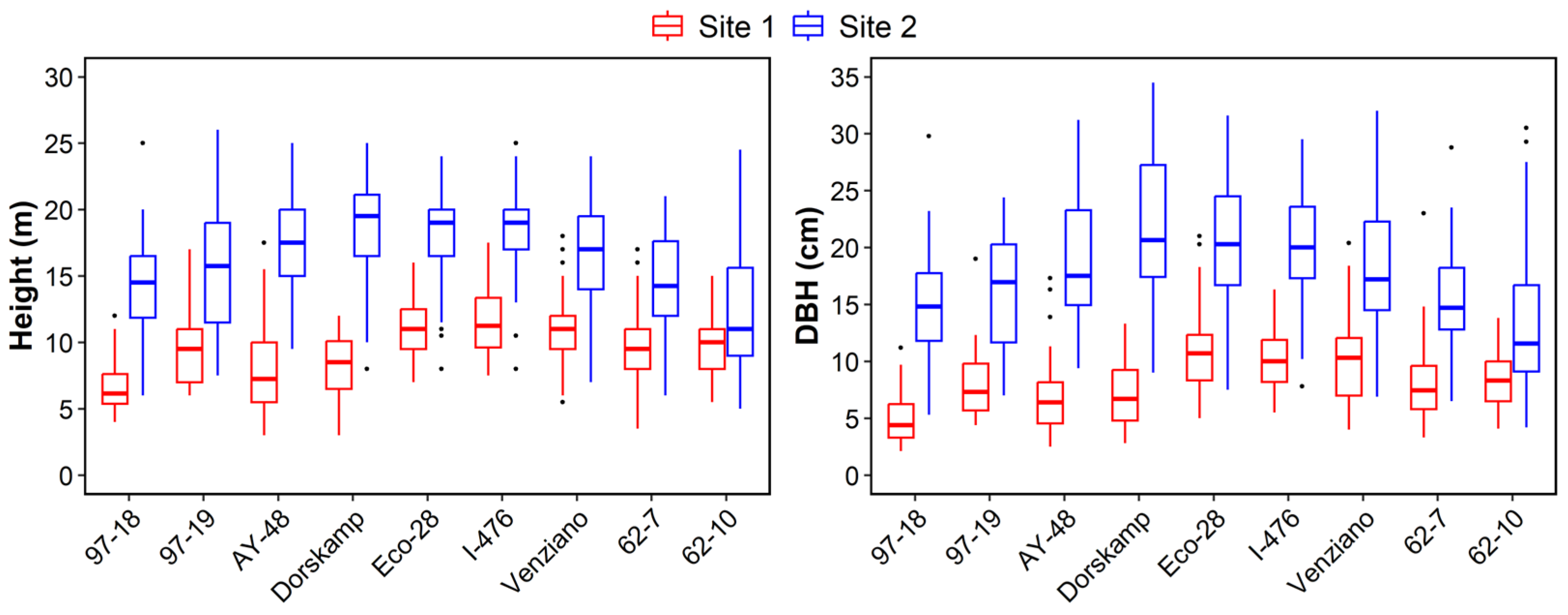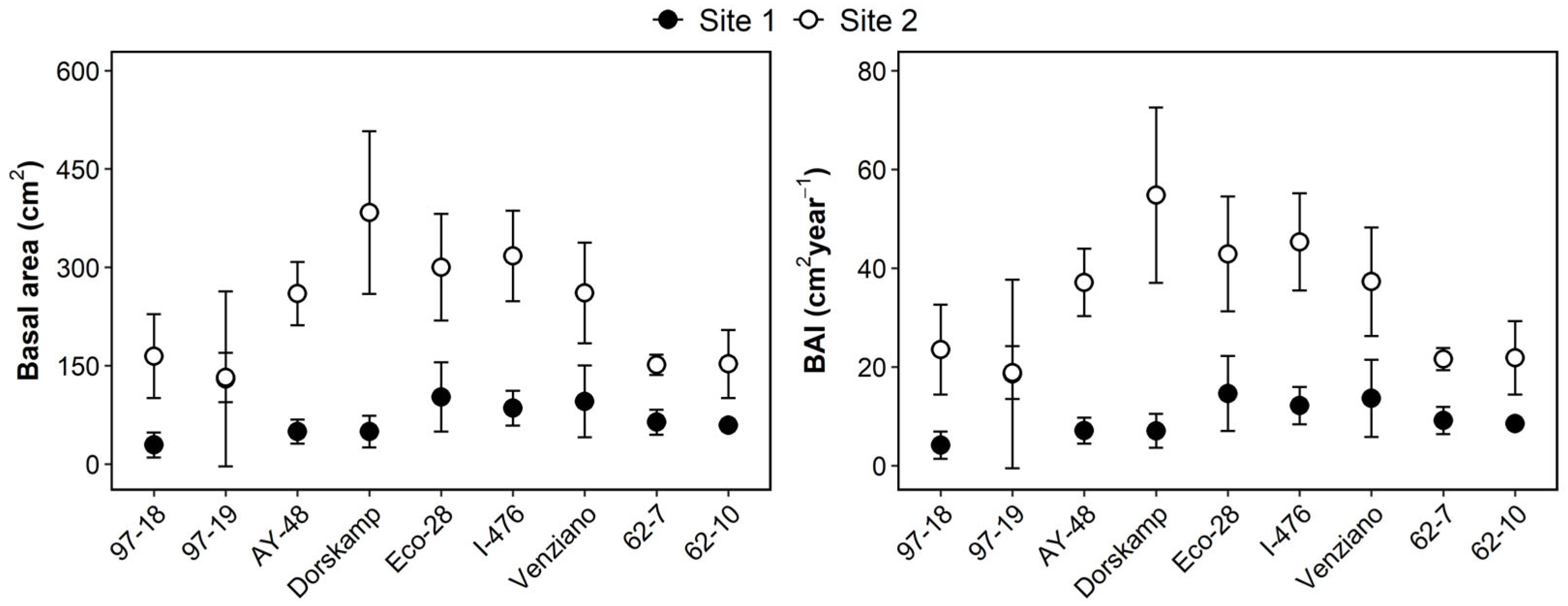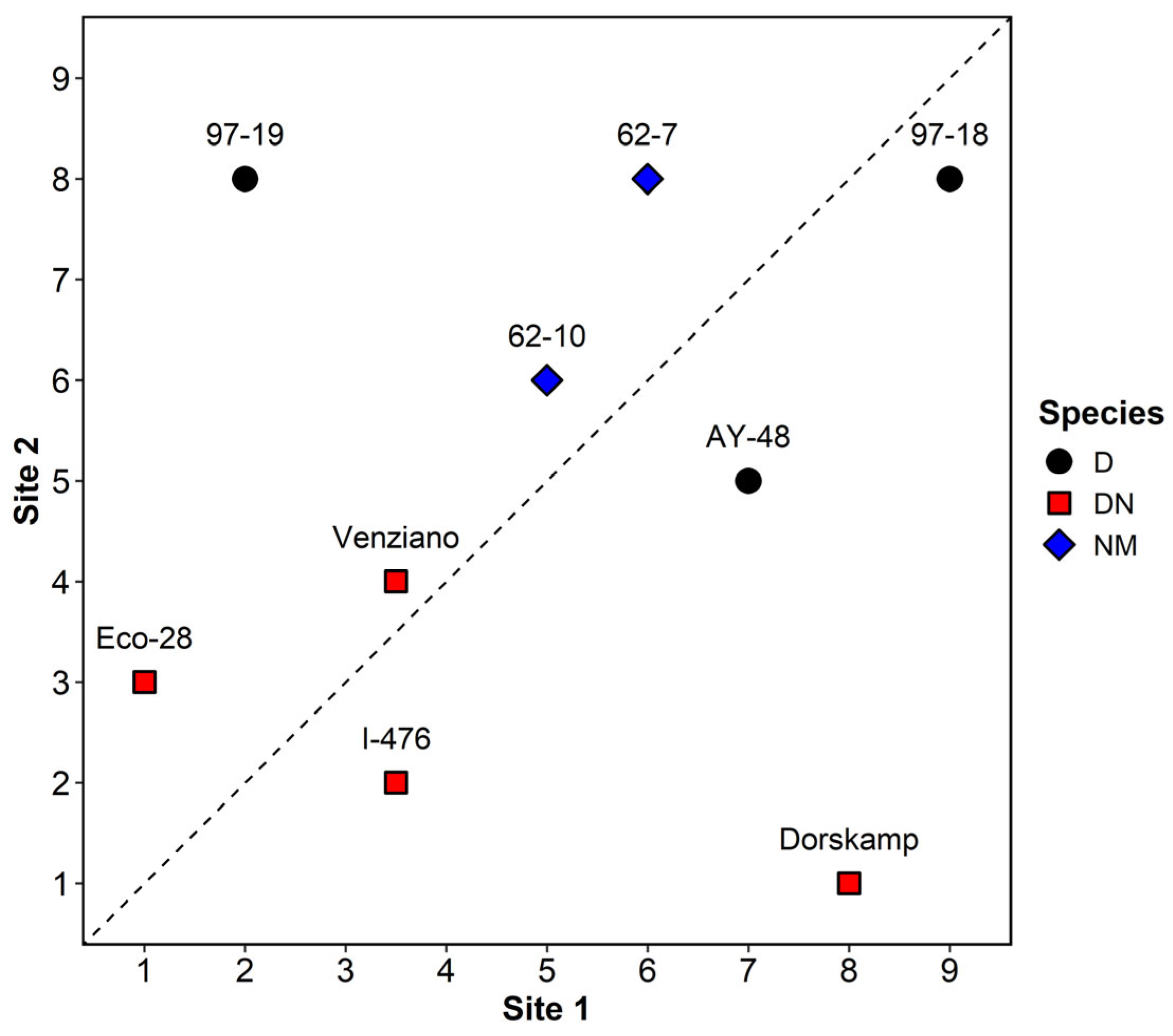Evaluating Growth and Stability of Nine Poplar Clones for Riparian Afforestation
Abstract
1. Introduction
2. Materials and Methods
2.1. Plant Materials
2.2. Study Sites
2.3. Experimental Setup
2.4. Survival and Grwoth Data
2.5. Soil Sampling and Analysis
2.6. Statistical Analyses
3. Results
3.1. Soil Texture and Chemical Properties
3.2. Survival Rate
3.3. Growth Performance
3.4. Consistency Between Survival and Growth Performance and Stability Evaluation
4. Discussion
4.1. Clonal Differences and Superiority of DN Hybrids in Riparian Conditions
4.2. Environmental Drivers of Site-Specific Performance Variation
4.3. Integrative Evaluation of Clonal Productivity and Stability
4.4. Implications for Clone Selection and Future Research in Riparian Forestry
5. Conclusions
Author Contributions
Funding
Data Availability Statement
Conflicts of Interest
References
- Rahman, G.; Kim, J.Y.; Kim, T.W.; Park, M.; Kwon, H.H. Spatial and Temporal Variations in Temperature and Precipitation Trends in South Korea over the Past Half-Century (1974–2023) Using Innovative Trend Analysis. J. Hydro-Environ. Res. 2025, 58, 1–18. [Google Scholar] [CrossRef]
- Yun, J. The Han River Development: Planning the Riverfront as Seoul’s Natural Landmark. Sustainability 2022, 14, 4011. [Google Scholar] [CrossRef]
- Naiman, R.J.; Fetherston, K.L.; McKay, S.J.; Chen, J. Riparian Forests. In River Ecology and Management: Lessons from the Pacific Coastal Ecoregion; Naiman, R.J., Bilby, R.E., Eds.; Springer: New York, NY, USA, 1998; pp. 289–323. [Google Scholar]
- Johnson, M.F.; Wilby, R.L. Seeing the Landscape for the Trees: Metrics to Guide Riparian Shade Management in River Catchments. Water Resour. Res. 2015, 51, 3754–3769. [Google Scholar] [CrossRef]
- Zellweger, F.; Coomes, D.; Lenoir, J.; Depauw, L.; Maes, S.L.; Wulf, M.; De Frenne, P. Seasonal Drivers of Understorey Temperature Buffering in Temperate Deciduous Forests across Europe. Glob. Ecol. Biogeogr. 2019, 28, 1774–1786. [Google Scholar] [CrossRef]
- Bahn, G.-S.; An, B.-C. Analysis of Environmental Purification Effect of Riparian Forest with Poplar Trees for Ecological Watershed Management: A Case Study in the Floodplain of the Dam Reservoir in Korea. Sustainability 2020, 12, 6871. [Google Scholar] [CrossRef]
- Fortier, J.; Truax, B.; Gagnon, D.; Lambert, F. Potential for Hybrid Poplar Riparian Buffers to Provide Ecosystem Services in Three Watersheds with Contrasting Agricultural Land Use. Forests 2016, 7, 37. [Google Scholar] [CrossRef]
- Isebrands, J.G.; Richardson, J. Poplars and Willows: Trees for Society and the Environment; CAB International and FAO: Rome, Italy, 2014; p. 634. [Google Scholar]
- Théroux Rancourt, G.; Éthier, G.; Pepin, S. Greater Efficiency of Water Use in Poplar Clones Having a Delayed Response of Mesophyll Conductance to Drought. Tree Physiol. 2015, 35, 172–184. [Google Scholar] [CrossRef] [PubMed]
- Xi, B.; Clothier, B.; Coleman, M.; Duan, J.; Hu, W.; Li, D.; Fernández, J.E. Irrigation Management in Poplar (Populus spp.) Plantations: A Review. For. Ecol. Manag. 2021, 494, 119330. [Google Scholar] [CrossRef]
- Sikorska, D.; Sikorski, P.; Archiciński, P.; Chormański, J.; Hopkins, R.J. You Can’t See the Woods for the Trees: Invasive Acer negundo L. in Urban Riparian Forests Harms Biodiversity and Limits Recreation Activity. Sustainability 2019, 11, 5838. [Google Scholar] [CrossRef]
- Havrdová, A.; Douda, J.; Doudová, J. Threats, Biodiversity Drivers and Restoration in Temperate Floodplain Forests Related to Spatial Scales. Sci. Total Environ. 2023, 854, 158743. [Google Scholar] [CrossRef]
- Richardson, J.; Isebrands, J.G.; Ball, J.B. Ecology and Physiology of Poplars and Willows. In Poplars and Willows: Trees for Society and the Environment; Isebrands, J.G., Richardson, J., Eds.; CAB International and FAO: Rome, Italy, 2014; pp. 92–124. [Google Scholar]
- Tsarev, A.; von Wühlisch, G.; Tsareva, R. Hybridization of Poplars in the Central Chernoff-Zem Region of Russia. Silvae Genet. 2017, 65, 1–10. [Google Scholar] [CrossRef][Green Version]
- Boothroyd-Roberts, K.; Gagnon, D.; Truax, B. Can Hybrid Poplar Plantations Accelerate the Restoration of Forest Understory Attributes on Abandoned Fields? For. Ecol. Manag. 2013, 287, 77–89. [Google Scholar] [CrossRef]
- Qin, G.-H.; Jiang, Y.-Z.; Qiao, Y.-L. Selection of Poplar Hybrid Clones (Populus spp.) from Backcrossed Progenies of the Aigeros Section for Industrial Purpose. Silvae Genet. 2013, 62, 52–61. [Google Scholar] [CrossRef]
- Nelson, N.; Meilan, R.; Berguson, W.; McMahon, B.; Cai, M.; Buchman, D. Growth Performance of Hybrid Poplar Clones on Two Agricultural Sites with and without Early Irrigation and Fertilization. Silvae Genet. 2019, 68, 58–66. [Google Scholar] [CrossRef]
- Yu, C.-B.; Chen, F.; Luo, Z.-J. Evaluation of Soil Nutrient Status in Poplar Forest Soil by Soil Nutrient Systematic Approach. J. For. Res. 2004, 15, 298–300. [Google Scholar] [CrossRef]
- Ghezehei, S.B.; Ewald, A.L.; Hazel, D.W.; Zalesny, R.S., Jr.; Nichols, E.G. Productivity and Profitability of Poplars on Fertile and Marginal Sandy Soils under Different Density and Fertilization Treatments. Forests 2021, 12, 869. [Google Scholar] [CrossRef]
- Kim, K.H.; Zsuffa, L. Reforestation of South Korea: The history and analysis of a unique case in forest tree improvement and forestry. For. Chron. 1994, 70, 58–64. [Google Scholar] [CrossRef]
- Rajora, O.P.; Zsuffa, L. Screening Populus deltoides Marsh. selections by allozymes to assure species identity. Scand. J. For. Res. 1991, 6, 471–478. [Google Scholar] [CrossRef]
- Stobrawa, K. Poplars (Populus spp.): Ecological role, applications and scientific perspectives in the 21st century. Balt. For. 2014, 20, 204–213. [Google Scholar]
- De Rigo, D.; Enescu, C.M.; Houston Durrant, T.; Caudullo, G. Populus nigra in Europe: Distribution, habitat, usage and threats. In European Atlas of Forest Tree Species; Publications Office of the European Union: Luxembourg, 2016; pp. 136–137. [Google Scholar]
- Kim, C.W.; Cha, D.S.; Choi, Y.E.; Koo, Y.B.; Choi, W.Y.; Oh, J.H.; Yi, J.S. Researches on Populus in Korea for various purposes. J. Korean For. Soc. 2009, 98, 513–523. [Google Scholar]
- Castro-Díez, P.; Alonso, Á. Effects of non-native riparian plants in riparian and fluvial ecosystems: A review for the Iberian Peninsula. Limnetica 2017, 36, 525–541. [Google Scholar] [CrossRef]
- Meyer, S.E.; Callaham, M.A., Jr.; Stewart, J.E.; Warren, S.D. Invasive species response to natural and anthropogenic disturbance. In Invasive Species in Forests and Rangelands of the United States: A Comprehensive Science Synthesis for the United States Forest Sector; Springer: Berlin/Heidelberg, Germany, 2021; pp. 85–110. [Google Scholar] [CrossRef]
- Gazoulis, I.; Antonopoulos, N.; Kanatas, P.; Karavas, N.; Bertoncelj, I.; Travlos, I. Invasive alien plant species—Raising awareness of a threat to biodiversity and ecological connectivity (EC) in the Adriatic–Ionian region. Diversity 2022, 14, 387. [Google Scholar] [CrossRef]
- Yeo, J.-K.; Woo, K.-S.; Koo, Y.-B.; Kim, Y.-S. Growth Performance and Adaptability of Three-Year-Old Poplar and Willow Clones in a Riparian Area. J. Korean Environ. Res. Reveg. Technol. 2007, 10, 40–50. [Google Scholar]
- Ashworth, J.; Keyes, D.; Kirk, R.; Lessard, R. Standard Procedure in the Hydrometer Method for Particle Size Analysis. Commun. Soil Sci. Plant Anal. 2001, 32, 633–642. [Google Scholar] [CrossRef]
- Thunjai, T.; Boyd, C.E.; Dube, K. Poind Soil pH Measurement. J. World Aquac. Soc. 2001, 32, 141–152. [Google Scholar] [CrossRef]
- Matejovic, I. Total Nitrogen in Plant Material Determinated by Means of Dry Combustion: A Possible Alternative to Determination by Kjeldahl Digestion. Commun. Soil Sci. Plant Anal. 1995, 26, 2217–2229. [Google Scholar] [CrossRef]
- Cox, M.S. The Lancaster Soil Test Method as an Alternative to the Mehlich 3 Soil Test Method. Soil Sci. 2001, 166, 484–489. [Google Scholar] [CrossRef]
- Aprile, F.; Lorandi, R. Evaluation of Cation Exchange Capacity (CEC) in Tropical Soils Using Four Different Analytical Methods. J. Agric. Sci. 2012, 4, 278. [Google Scholar] [CrossRef]
- David, D.J. The Determination of Exchangeable Sodium, Potassium, Calcium and Magnesium in Soils by Atomic-Absorption Spectrophotometry. Analyst 1960, 85, 495–503. [Google Scholar] [CrossRef]
- R Core Team. R: A Language and Environment for Statistical Computing; R Foundation for Statistical Computing: Vienna, Austria, 2025; Available online: https://www.R-project.org (accessed on 12 May 2025).
- Zalesny, R.S., Jr.; Riemenschneider, D.E.; Hall, R.B. Early rooting of dormant hardwood cuttings of Populus: Analysis of quantitative genetics and genotype × environment interactions. Can. J. For. Res. 2005, 35, 918–929. [Google Scholar] [CrossRef]
- Sixto, H.; Salvia, J.; Barrio, M.; Ciria, M.P.; Cañellas, I. Genetic variation and genotype-environment interactions in short rotation Populus plantations in southern Europe. New For. 2011, 42, 163–177. [Google Scholar] [CrossRef]
- Pliura, A.; Lygis, V.; Suchockas, V.; Bartkevicius, E. Performance of twenty four European Fraxinus excelsior populations in three Lithuanian progeny trials with a special emphasis on resistance to Chalara fraxinea. Baltic For. 2011, 17, 17–34. [Google Scholar]
- Mathew, I.; Shimelis, H. Genetic analyses of root traits: Implications for environmental adaptation and new variety development: A review. Plant Breed. 2022, 141, 695–718. [Google Scholar] [CrossRef]
- Schuster, A.; Santana, A.S.; Uberti, A.; Dias, F.D.S.; Dos Reis, H.M.; Destro, V.; DeLima, R.O. Genetic diversity, relationships among traits and selection of tropical maize inbred lines for low-P tolerance based on root and shoot traits at seedling stage. Front. Plant Sci. 2024, 15, 1429901. [Google Scholar] [CrossRef]
- Tian, Y.; Liu, Y.; Fang, S.; Yue, J.; Xu, X. Genotypic Variations in 107 Poplar Clones Grown on a Short-Term Waterlogging Site: Long-Term (1992–2015) Data on Survival Rate, Growth Performance and Branching Traits. Data Brief 2021, 34, 106711. [Google Scholar] [CrossRef]
- Lyon, J.; Gross, N.M. Patterns of plant diversity and plant–environmental relationships across three riparian corridors. For. Ecol. Manag. 2005, 204, 267–278. [Google Scholar] [CrossRef]
- Kinnoumè, S.M.D.; Gouwakinnou, G.N.; Noulèkoun, F.; Balagueman, R.O.; Houehanou, T.D.; Natta, A.K. Trees diversity explains variations in biodiversity–ecosystem function relationships across environmental gradients and conservation status in riparian corridors. Front. For. Glob. Change 2024, 7, 1291252. [Google Scholar] [CrossRef]




| Pedigree | Group | Clone |
|---|---|---|
| P. deltoides × P. deltoides | D | 97-18, 97-19, and AY48 |
| P. deltoides × P. nigra | DN | Dorskamp, Eco28, I-476, and Venziano |
| P. nigra × P. suaveolens | NS | 62-7 and 62-10 |
| Site 1 (Yangpyeong) | Site 2 (Seoul) | p-Value | |
|---|---|---|---|
| Soil texture | Silt loam | Silt loam | |
| Soil pH | 5.2 ± 0.2 | 6.0 ± 0.6 | 0.081 |
| Organic matter (g/kg) | 16.3 ± 8.5 | 18.7 ± 10.1 | 0.775 |
| Phosphorus pentoxide (mg/kg) | 65.0 ± 7.5 | 80.0 ± 65.3 | 0.730 |
| Exchangeable K (cmol/kg) | 0.13 ± 0.10 | 0.46 ± 0.10 | 0.014 |
| Exchangeable Ca (cmol/kg) | 0.33 ± 0.21 | 6.17 ± 1.10 | 0.010 |
| Exchangeable Mg (cmol/kg) | 0.13 ± 0.06 | 1.20 ± 0.17 | <0.001 |
| Silicic acid (mg/kg) | 91.0 ± 12.1 | 155.0 ± 41.3 | 0.062 |
| Ion conductivity (dS/m) | 0.13 ± 0.06 | 0.33 ± 0.23 | 0.270 |
| Na (ESP%) | 0.03 ± 0.01 | 0.26 ± 0.04 | <0.001 |
| Group | Clone | Survival Rate (%) | |
|---|---|---|---|
| Site 1 | Site 2 | ||
| D | 97-18 | 23.5 ± 15.6 | 80.0 ± 10.0 |
| 97-19 | 17.6 ± 15.6 | 56.7 ± 5.8 | |
| AY-48 | 58.8 ± 15.6 | 85.0 ± 8.7 | |
| DN | Dorskamp | 45.1 ± 6.8 | 93.3 ± 2.9 |
| Eco-28 | 84.3 ± 9.0 | 88.3 ± 7.6 | |
| I-476 | 98.0 ± 3.4 | 93.3 ± 7.6 | |
| Venziano | 70.6 ± 21.2 | 88.3 ± 5.8 | |
| NS | 62-7 | 62.7 ± 14.8 | 73.3 ± 12.6 |
| 62-10 | 80.4 ± 18.0 | 86.7 ± 15.3 | |
| Group | Clone | CV | Rank | |||
|---|---|---|---|---|---|---|
| Survival | DBH | Volume | BAI | |||
| D | 97-18 | 64.1 | 53.2 | 107.7 | 88.3 | 9 |
| 97-19 | 63.9 | 36.7 | 68.1 | 67.0 | 6 | |
| AY-48 | 25.4 | 51.8 | 96.1 | 77.3 | 5 | |
| DN | Dorskamp | 38.9 | 56.8 | 108.2 | 92.2 | 3 |
| Eco-28 | 9.2 | 38.1 | 89.8 | 61.9 | 1 | |
| I-476 | 6.2 | 39.5 | 85.5 | 67.3 | 2 | |
| Venziano | 21.4 | 37.5 | 84.2 | 60.9 | 4 | |
| NS | 62-7 | 19.9 | 34.7 | 70.7 | 46.8 | 8 |
| 62-10 | 18.3 | 34.7 | 105.5 | 57.4 | 7 | |
Disclaimer/Publisher’s Note: The statements, opinions and data contained in all publications are solely those of the individual author(s) and contributor(s) and not of MDPI and/or the editor(s). MDPI and/or the editor(s) disclaim responsibility for any injury to people or property resulting from any ideas, methods, instructions or products referred to in the content. |
© 2025 by the authors. Licensee MDPI, Basel, Switzerland. This article is an open access article distributed under the terms and conditions of the Creative Commons Attribution (CC BY) license (https://creativecommons.org/licenses/by/4.0/).
Share and Cite
Jeon, J.; Lim, H.; Lee, K.; Noh, E.W.; Lee, I.H.; Lee, W.Y.; Koo, Y.B.; Jang, K. Evaluating Growth and Stability of Nine Poplar Clones for Riparian Afforestation. Plants 2025, 14, 2482. https://doi.org/10.3390/plants14162482
Jeon J, Lim H, Lee K, Noh EW, Lee IH, Lee WY, Koo YB, Jang K. Evaluating Growth and Stability of Nine Poplar Clones for Riparian Afforestation. Plants. 2025; 14(16):2482. https://doi.org/10.3390/plants14162482
Chicago/Turabian StyleJeon, Jihyeon, Hyemin Lim, Kyungmi Lee, Eun Woon Noh, Il Hwan Lee, Wi Young Lee, Yeong Bon Koo, and Kyunghwan Jang. 2025. "Evaluating Growth and Stability of Nine Poplar Clones for Riparian Afforestation" Plants 14, no. 16: 2482. https://doi.org/10.3390/plants14162482
APA StyleJeon, J., Lim, H., Lee, K., Noh, E. W., Lee, I. H., Lee, W. Y., Koo, Y. B., & Jang, K. (2025). Evaluating Growth and Stability of Nine Poplar Clones for Riparian Afforestation. Plants, 14(16), 2482. https://doi.org/10.3390/plants14162482






